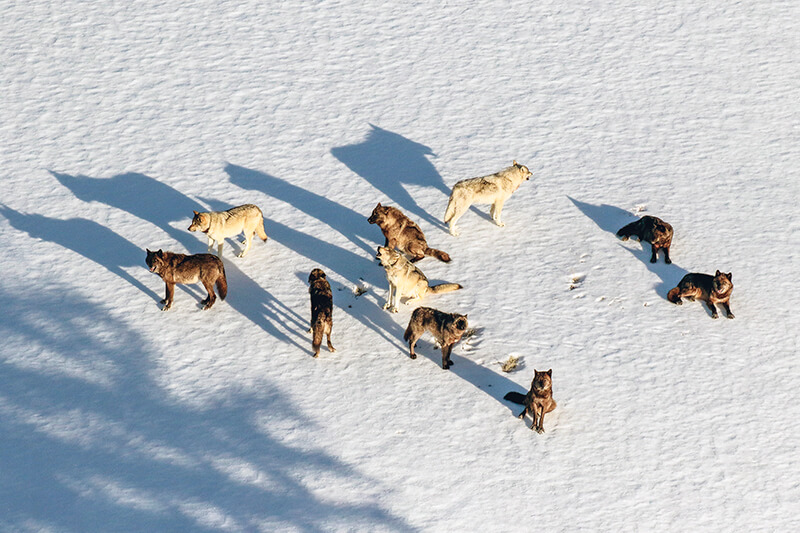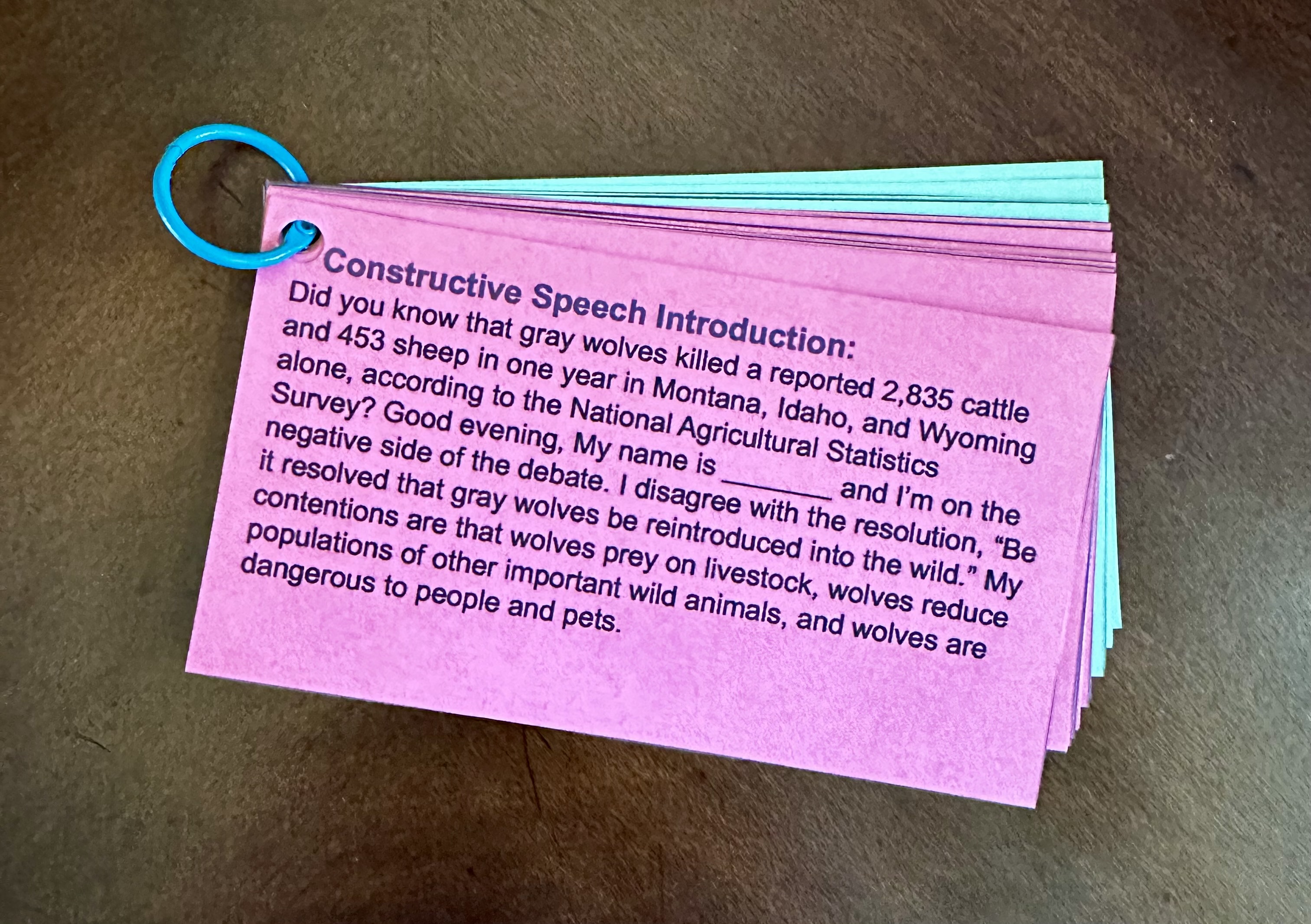Gray Wolves
Gray wolves are large, carnivorous mammals that can adapt to a variety of habitats, including forests, tundras, deserts, and grasslands. Adult gray wolves weigh between 60-130 pounds and are about 26-32 inches tall at the shoulder. Males are generally larger than females. They have long legs, a narrow chest, and large paws, that help them travel long distances. Gray wolves are highly social animals that live in packs ranging from two to over twenty wolves.
Gray wolves are apex predators with a diet primarily consisting of large ungulates such as deer, elk, moose, and caribou. They also eat smaller mammals, birds, and occasionally fruits and vegetables. Wolves hunt in packs using their numbers and coordinated strategies to bring down prey much larger than themselves. They rely on their keen senses of smell, hearing, and sight to track and capture prey.
Gray wolves, once widespread across North America, were listed as endangered in the United States under the Endangered Species Act (ESA) in 1974 due to habitat loss, hunting, and government-sponsored eradication programs. This classification provided federal protection and led to conservation and recovery efforts.
With the goals of restoring ecological balance, enhancing biodiversity, and destabilizing predator-prey dynamics, 31 gray wolves from Canada were released into Yellowstone National Park and central Idaho in 1995. The reintroduced wolf populations in the Northern Rockies have grown and expanded their range. Reintroduction programs have also been initiated in other regions, such as the Great Lakes, Pacific Northwest, and most recently, Colorado.
Stakeholders Affected by the Reintroduction of Gray Wolves
The reintroduction of gray wolves affects a wide range of stakeholders with different viewpoints including:
- Ranchers and Farmers: Livestock owners are directly affected by wolf predation on cattle, sheep, and other animals. This can lead to economic losses, increased stress, and the need for compensation programs and protective measures.
- Tourism Industry: Local economies, particularly in areas like Yellowstone National Park, benefit from increased tourism due to wolf-watching opportunities. Wildlife enthusiasts, photographers, and researchers contribute to economic activity.
- Local Communities: Rural and agricultural communities near wolf habitats experience changes in their daily lives, including potential threats to livestock and pets, which can lead to fear and opposition to wolf reintroduction.
- Conservationists and Environmentalists: These groups often support wolf reintroduction due to its ecological benefits and its role in restoring natural ecosystems. They may be involved in advocacy, education, and funding efforts.
- General Public: Public perceptions of wolves can be mixed, influenced by cultural attitudes, media representation, and personal experiences.
- Government Agencies: Agencies responsible for wildlife management, such as the U.S. Fish and Wildlife Service and state wildlife departments, play a crucial role in planning, implementing, and monitoring wolf reintroduction programs. They also manage compensation programs for livestock loss.
- Policymakers: Local, state, and federal policymakers are involved in creating and enforcing regulations related to wolf reintroduction and protection. Legal battles over the status of wolves under the ESA can be significant.
- Scientists and Researchers: Ecologists, biologists, and other researchers study the impacts of wolf reintroduction on ecosystems, providing valuable data that informs management practices and conservation strategies.
- Wildlife Enthusiasts: Ecotourists, wildlife watchers, and photographers are drawn to areas where wolves have been reintroduced, enhancing recreational opportunities and contributing to local economies.
- Outdoor Recreationists: Hunters, hikers, and other outdoor enthusiasts may experience changes in wildlife dynamics and recreational opportunities due to the presence of wolves.
The status of gray wolves under the ESA has been contentious, with multiple legal battles over delisting and relisting them as endangered or threatened species. Their status continues to be a point of legal and political debate.
Arguments in Favor of the Reintroduction of Gray Wolves:
- Wolves help regulate the populations of large herbivores such as deer and elk, which prevents overgrazing. This allows vegetation to recover and supports a diverse array of other species, including beavers, birds, and fish, contributing to a more balanced and diverse ecosystem.
- Reduced herbivore pressure on streamside vegetation helps improve riparian habitats. This can lead to better water quality, reduced soil erosion, and enhanced habitats for fish and amphibians.
- Wolves help control the populations of smaller predators such as coyotes, which can lead to an increase in the populations of small mammals and ground-nesting birds.
- The presence of wolves attracts tourists, particularly to national parks like Yellowstone. Wildlife enthusiasts, photographers, and researchers contribute to local economies through tourism-related spending on lodging, food, and other services. Wolves enrich the wildlife viewing experience for park visitors and nature enthusiasts, contributing to a deeper appreciation for natural ecosystems.
- The reintroduction of wolves provides opportunities for scientific research and environmental education. This can lead to increased funding and awareness for conservation initiatives.
- Wolves are a keystone species and their return symbolizes the restoration of natural ecosystems to their historical state. This has cultural and intrinsic value, reflecting a commitment to preserving biodiversity and natural heritage.
- Reintroducing wolves addresses past wrongs related to human-led eradication efforts. It reflects a societal move towards ethical stewardship of the environment and recognition of the intrinsic value of wildlife.
- The reintroduction of apex predators like wolves has led to more comprehensive and holistic ecosystem management practices, promoting the health of entire ecosystems rather than focusing on individual species.
Arguments Against the Reintroduction of Gray Wolves:
- Wolves can prey on livestock, causing economic losses for ranchers and farmers. Although compensation programs exist, they may not cover the losses or the emotional impact on livestock owners.
- Implementing and maintaining wolf reintroduction programs, including monitoring, management, and compensation for livestock losses, can be costly for government agencies and conservation organizations.
- The presence of wolves near human settlements can lead to conflicts, particularly when wolves prey on pets or encroach on residential areas, causing fear and safety concerns among local communities.
- Some rural and agricultural communities strongly oppose wolf reintroduction due to threats to their livelihoods and lifestyles. This opposition can lead to tensions and conflicts between different stakeholder groups.
- Wolves can reduce populations of other predators, such as coyotes, through direct competition and predation. This can alter the balance of local ecosystems and affect other species that rely on these predators.
- The presence of wolves may have unforeseen and complex ecological effects, such as changes in prey populations and behaviors that may not always be beneficial.
- The legal status of wolves, including protections under the ESA, has been a contentious issue. Decisions to delist or relist wolves can lead to lengthy legal battles and fluctuating management policies, creating uncertainty and frustration among stakeholders.
- Funding and resources allocated to wolf reintroduction programs may divert attention and resources away from other conservation priorities, potentially neglecting other species or ecosystems in need of protection.
- Finding and maintaining sustainable habitats for wolves can be challenging due to habitat fragmentation, human development, and land-use changes. Ensuring connectivity between habitats is crucial for the long-term success of wolf populations.
- Effective monitoring and management of reintroduced wolf populations requires significant effort and coordination. Ensuring that wolf populations remain healthy and do not negatively impact other species or human interests can be complex and demanding.
Benefits of Engaging in Debates
Engaging in debates equips students with a wide range of skills that are beneficial for their overall development and future success:
- Critical Thinking: Debates encourage students to analyze different sides of an issue, enhancing their ability to think critically and make informed decisions. It also helps them assess the validity of arguments and evidence.
- Communication Skills: Debating improves students' public speaking skills and helps them learn to articulate their thoughts clearly and concisely.
- Research Skills: Students learn to gather relevant information and evidence to support their arguments and to evaluate the credibility and reliability of different sources.
- Collaboration and Teamwork: Debating in teams teaches students to work collaboratively, share responsibilities, and support each other. Students learn to listen to their teammates and opponents, fostering better understanding and respect for different viewpoints.
- Confidence: Successfully participating in debates boosts students' confidence in their ability to express their ideas and opinions.
- Empathy and Understanding: Debating requires students to understand and articulate viewpoints that may differ from their own, promoting empathy and an appreciation of the complexity of certain issues and the existence of multiple perspectives. It fosters respect for diverse opinions and encourages open-mindedness.
- Civic Engagement: Instills an interest in social issues and the importance of active participation in discussions.
- Organizational Skills: Develops the ability to structure thoughts and evidence and present them in a clear and logical manner.
Basic Debate Format
The debate begins with a resolution. For this lesson the resolution is, "Be it resolved that gray wolves be reintroduced into the wild." Each side of the debate (affirmative—in favor of the resolution and negative—against the resolution) is represented by a team of two students. Each student gives a three-minute constructive speech in which they present three contentions with evidence that supports their side of the debate. After all constructive speeches have been heard, there is a two minute prep time for the teams to organize their rebuttal speeches. Each student gives a two-minute rebuttal speech in which they refute three of the contentions presented by the opposing team. (Example of completed cards for teacher reference) The following schedule is used to organize the debate:
- 1st Affirmative Constructive Speech (3 minutes)
- 1st Negative Constructive Speech (3 minutes)
- 2nd Affirmative Constructive Speech (3 minutes)
- 2nd Negative Constructive Speech (3 minutes)
- Prep Time (2 minutes)
- 1st Negative Rebuttal Speech (2 minutes)
- 1st Affirmative Rebuttal Speech (2 minutes)
- 2nd Negative Rebuttal Speech (2 minutes)
- 2nd Affirmative Rebuttal Speech (2 minutes)
The Debate Rubric is used to score the debate participants.

 Write the numbers 1-6 on a beach ball with a marker. Stand in the middle of the room and hold the ball up for the students to see. Without rotating the ball, ask students in various parts of the room which number(s) they can see. For example, ask a student on the left side of the classroom what number they see, followed by the same question to a student on the right side of the room and so on. Each student will see all or part of different numbers.
Write the numbers 1-6 on a beach ball with a marker. Stand in the middle of the room and hold the ball up for the students to see. Without rotating the ball, ask students in various parts of the room which number(s) they can see. For example, ask a student on the left side of the classroom what number they see, followed by the same question to a student on the right side of the room and so on. Each student will see all or part of different numbers.